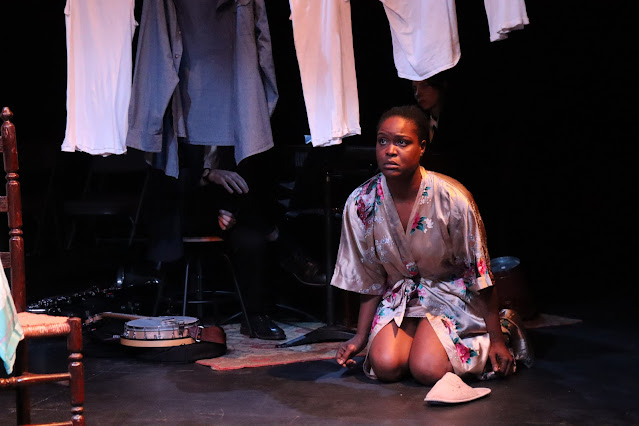The Hand That Feeds You
Written by Sarah Groustra
Directed by Jennie Hughes
115 MacDougal Street, Manhattan, NYC
December 5-22, 2024
 |
| L to R: Laurel Andersen, Juan Castro, and Jonathan Lorenzo Price. Photo by Kat duPont Veccio. |
Film critic and scholar Robin Wood described the monster as the return of the repressed, and if Wood is focused more specifically on social repression than individual psychology, his description is nevertheless a useful way to think about the dynamic at the center of Sarah Groustra's new play,
The Hand That Feeds You. Seen symbolically, the monster in this winningly outlandish comedy horror manifests feelings about self and family that protagonist John Gerber (
Juan Castro) would prefer to avoid and forget (some of which certainly link to larger social attitudes). In
The Hand That Feeds You, the monstrous prompts us to wonder what might be lurking not only in the backroom of the local butcher's but also in the walled-off areas of individual memory and mind.
The Hand That Feeds You opens with John smoking in the rain beneath a lamppost, preparing himself to enter his namesake establishment, Gerber's Meat Market, a business that has been in the family for several generations. John, we learn as the play unfolds, has returned to suburban New York after having spent a number of years in California, as far away from his father and the Meat Market as he could get without leaving the country. His return was motivated by his father's terminal illness, and now Gerber's Meat Market belongs to John, who plans to demolish its interior - and the past it represents - and turn it into a French bistro, with the help of his longtime best friend, Todd (Jonathan Lorenzo Price). In addition to mental and emotional baggage, though, the store that John has inherited also comes, unbeknownst to him, with a meat monster (
Laurel Andersen), a being who constructed themself a body from the butcher's shop offcuts. This self-made golem, who goes by the inarguably apposite name of Meat, has, as per a blood pact with John's great-grandfather, lived in the Meat Market ever since and, contra John's renovation plans, has no wish to leave their established home.
 |
Juan Castro and Jonathan Lorenzo Price. Photo by Kat duPont Veccio.
|
In this resistance to change, Meat both contrasts John's desire for a fresh start with the store and reflects his own stultification and disgust with himself, directed variously at his own body, abilities, and worthiness - feelings that are at once affected by his estranged relationship with his father and affect his relationships with others, including, importantly, Todd. Meat, in a great textile-based costume designed by Iris Rodrigo and Jennie Hughes, is basically a walking, talking, smelly embodiment of abjection; and the way that they resist John's plans - and offer a different perspective on his father - forces him to reckon with, and perhaps alter, what he has placed outside of his personal boundaries. John's struggles possess their own particularity, but aspects such as his insecurity vis-à-vis his body in the face of dominant social images, as well as the fact that human beings are always already dying agglomerations of animated meat, represent pretty universally relatable experiences. Given such experiences, the play posits, rather than closing oneself off via repression, one should open oneself to the possibility of finding the love and security of "home" in a person (or people) who may not be biological relatives but who can act as family - and more.
 |
Laurel Andersen. Photo by Kat duPont Veccio.
|
Price's Todd is a warm, endearing presence, not to mention very funny, whether in his subtle reaction to an unexpected physical greeting by John or his (much) more pronounced reaction to encountering Meat for the first time. Castro and Andersen are not only equally hilarious, as in Meat's initial attraction to Todd, and affecting, as in John's opening the final missive from his deceased father, but also handily pull off the challenge of playing different versions of their characters (and, at different points, get to show off some dance moves). Framing these performances is some great production design, from Clay Baker-Lerner's set to subtle symbolic changes in John's costuming and hair and spooky special and lighting effects in a pair of scenes involving souls. Disarmingly humorous and humane, confidently inventive and unconventional,
The Hand That Feeds You has plenty of bite.
-John R. Ziegler and Leah Richards






Comments
Post a Comment